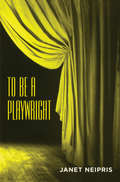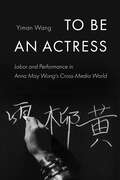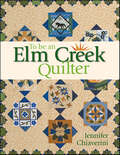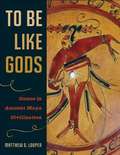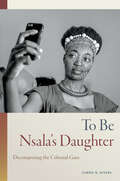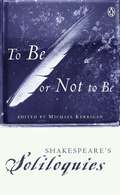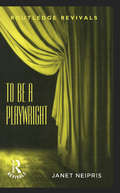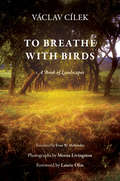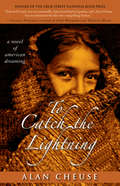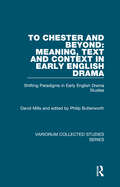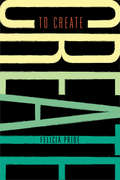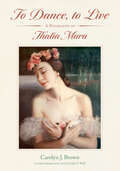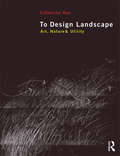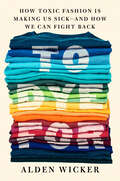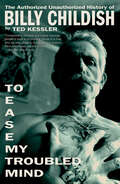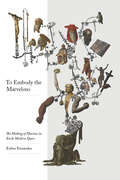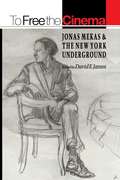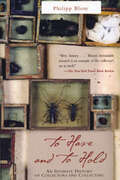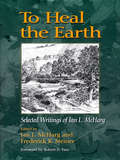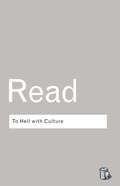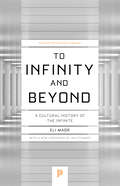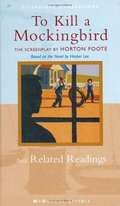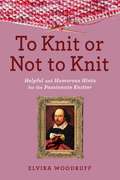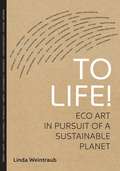- Table View
- List View
To All Generations
by Clara Bernice MillerA story of the Amish and Mennonite communities in a southeastern Iowa town through the eyes of one of its oldtimers, 88-year-old Daniel Brenneman.
To Be a Playwright
by Janet NeiprisFirst Published in 2006. Routledge is an imprint of Taylor & Francis, an informa company.
To Be an Actress: Labor and Performance in Anna May Wong's Cross-Media World (Feminist Media Histories #7)
by Yiman WangA free ebook version of this title is available through Luminos, University of California Press’s Open Access publishing program. Visit www.luminosoa.org to learn more. Between 1919 and 1961, pioneering Chinese American actress Anna May Wong established an enduring legacy that encompassed cinema, theater, radio, and American television. Born in Los Angeles, yet with her US citizenship scrutinized due to the Chinese Exclusion Act, Wong—a defiant misfit—innovated nuanced performances to subvert the racism and sexism that beset her life and career. In this critical study of Wong's cross-media and transnational career, Yiman Wang marshals extraordinary archival research and a multifocal approach to illuminate a lifelong labor of performance. Viewing Wong as a performer and worker, not just a star, To Be an Actress adopts a feminist decolonial perspective to speculatively meet her as an interlocutor while inviting a reconsideration of racialized, gendered, and migratory labor as the bedrock of the entertainment industries.
To Be an Elm Creek Quilter
by Jennifer Chiaverini• Patterns for 10 beautiful blocks combine piecing with appliqué for a unique sampler • Bring a little of Elm Creek into your own home • Get started right away with just a few clicks To celebrate the release of Circle of Quilters, the 9th novel in the Elm Creek Quilts series, Jennifer Chiaverini launched a quilt block design contest to her fans. The block that best captured the spirit of Elm Creek Quilts would become the series' new logo. Block designs from the top 10 finalists in this contest, never before published, are featured here. Important note about this ebook: The pdf you receive will be watermarked in the margin with your customer name. You may download the file a maximum of 3 times for your personal use only. Sharing and/or distribution of the file - whether for profit or not - is strictly prohibited. The digital file contains patterns that may not print true to size and may require sizing adjustments (inchmarks are included on patterns for reference). Depending on your viewing application or device, printing desired page may result in multiple printed pages.
To Be Like Gods: Dance in Ancient Maya Civilization
by Looper Matthew G.The Maya of Mexico and Central America have performed ritual dances for more than two millennia. Dance is still an essential component of religious experience today, serving as a medium for communication with the supernatural. During the Late Classic period (AD 600-900), dance assumed additional importance in Maya royal courts through an association with feasting and gift exchange. These performances allowed rulers to forge political alliances and demonstrate their control of trade in luxury goods. The aesthetic values embodied in these performances were closely tied to Maya social structure, expressing notions of gender, rank, and status. Dance was thus not simply entertainment, but was fundamental to ancient Maya notions of social, religious, and political identity. Using an innovative interdisciplinary approach, Matthew Looper examines several types of data relevant to ancient Maya dance, including hieroglyphic texts, pictorial images in diverse media, and architecture. A series of case studies illustrates the application of various analytical methodologies and offers interpretations of the form, meaning, and social significance of dance performance. Although the nuances of movement in Maya dances are impossible to recover, Looper demonstrates that a wealth of other data survives which allows a detailed consideration of many aspects of performance. To Be Like Gods thus provides the first comprehensive interpretation of the role of dance in ancient Maya society and also serves as a model for comparative research in the archaeology of performance.
To Be Nsala's Daughter: Decomposing the Colonial Gaze
by Chérie N. RiversIn To Be Nsala’s Daughter, Chérie N. Rivers shows how colonial systems of normalized violence condition the way we see and, through collaboration with contemporary Congolese artists, imagines ways we might learn to see differently. Rivers focuses on a photograph of a Congolese man, Nsala, looking at the disembodied hand and foot of his daughter, which were removed as punishment for his failure to deliver the requisite amount of rubber in King Léopold’s Congo. This photograph, taken by British missionary Alice Seeley Harris, featured prominently in abolitionist campaigns to end colonial atrocities in Central Africa in the early twentieth century. But in addition to exposing the visible violence of colonialism, Rivers argues, this photograph also exposes the invisible—and continued—violence of the colonial gaze. With a poetic, personal collage of stories and images, To Be Nsala’s Daughter traces the past and present of the colonial gaze both in Congo and in the author’s lived experience as a mixed-race Black woman in the United States.
To Be or Not to Be: Shakespeare's Soliloquies
by William ShakespeareA unique collection of Shakespeare's soliloquies, each introduced by concise and informative editorial notes. This is an edition to complement the highly successful SHAKESPEARE'S SONNETS and is published in commemoration of Shakespeare's birthday. Aperfect book for Shakespeare lovers and enthusiasts.
To Be A Playwright (Routledge Revivals)
by Janet NeiprisOriginally published in 2005, To Be A Playwright is an insightful and detailed guide to the craft of playwriting. Part memoir and part how-to guide, this useful book outlines the tools and techniques necessary to the aspiring playwright. Comprised of a collection of memoirs and lectures which blend seamlessly to deliver a practical hands-on guide to playwriting, this book illuminates the elusive challenges confronting creators of dynamic expression and offers a roadmap to craft of playwrighting.
To Breathe with Birds: A Book of Landscapes (Penn Studies in Landscape Architecture)
by Václav CílekJust as there is love at first sight between people, Václav Cílek writes, there can be love at first sight between a person and a place. A landscape is more than a location, it is one party in a relationship—even when the spirit of a certain setting is not perceptible to those who visit. But whether we travel to experience rapture or excitement, to discover truth and beauty, or to be dazzled, we search for the essence of faraway landscapes to gain perspective on our own place within the world. To Breathe with Birds delves into the imaginative and emotional bonds we form with landscapes and how human existence—a recent development, geologically speaking—shapes and is shaped by a sense of place.In subtle and lyrical prose, renowned geologist and author Václav Cílek explores topics from the history of asphalt to the spirits we imagine in trees, from geodiversity to the mathematics of snowflakes. Weaving earth science and environmentalism together with memoir and myth, his chapters visit resonant locations from India to Massachusetts, though most are deeply rooted in the river-laced, war-scarred landscape of Cílek's Czech homeland. These reflections are accompanied by Morna Livingston's evocative photographs, which capture the beauty and strangeness of natural and human-made forms. The first book-length appearance of Cílek's work in English translation, To Breathe with Birds offers insightful perspectives on the symbolism of landscapes as we struggle to conserve and protect the depleted earth.
To Catch the Lightning: A Novel of American Dreaming
by Alan CheuseThe critically acclaimed winner of the Grub Street National Book Prize for Fiction. Until someone tells you, you never know in whose dreams you appear... -from the prologue. Beginning in the late 1890s, Edward Sheriff Curtis embarked on an overwhelming odyssey to document and photograph the fading way of life of the American Indian. In To Catch the Lightning, Alan Cheuse creates a remarkable portrait of the man who would become a legend. Curtis turned his lens on a landscape of unparalleled beauty and tradition, and in so doing, became the architect of the finest lasting visual record of a culture close to extinction. Here is a haunting tale of the struggle between ambition and duty and a testament to the power of the sacrifices we make for the dreams that compel us. "Digs deep into the mystery and sacrifice and selfishness of creative vision." Charles Frazier. "A worthy effort... illuminating unknown corners of a great photographer's life." Kirkus Reviews
To Chester and Beyond: Shifting Paradigms in Early English Drama Studies
by David MillsThis volume brings together a selection of the major articles of David Mills (1938-2013), which along with similar volumes by Alexandra F. Johnston, Peter Meredith and Meg Twycross makes up a set of "Shifting Paradigms in Early English Drama Studies". Mills was one of these four key scholars whose work has changed what is known about English medieval drama and theatre. He made major contributions to understanding English medieval theatre in the widest sense but more specifically to the nature and development of medieval plays and their performance at Chester. The scope of his work from manuscript to performance has created new knowledge and insights brought about by his remarkable technical skill as an editor and researcher. His texts of the Chester Cycle of Mystery Plays have become the standard works. In the light of this outstanding research the volume is comprised of four sections: 1. Editors and Editing; 2. Cultural Contexts; 3. Staging and Performance; 4. Criticism and Evaluation. An editorial introduction opens the work.
To Create
by Felicia PrideTo Create is a collection of illuminating interviews with an eclectic set of black artists-including Harry Belafonte, Method Man, Nikki Giovanni, Edwidge Danticat, Edward P. Jones, Booker T. Mattison, and more-as conducted by the writer, entrepreneur, educator, and consultant Felicia Pride. This is an honest, inspiring series of conversations in which Pride and her fellow artists talk openly about the challenges and rewards of working creatively across a multitude of platforms.Over the course of dozens of frank discussions with writers, activists, and media creators, Pride elicits sincere firsthand perspectives on the struggle to find-or to create, if it's not there-a niche for one's voice in the media landscape. The personable and fluid interview style allows the artists to follow their threads of dialogue to unique, intimate revelations.The interviews transition smoothly between similar themes, touching on the do-it-yourself mentality of creating; practical musings on media careers; as well as theoretical discussions on art, legacy, and community. Additionally, many of the artists, musicians, and authors discuss finding career longevity through a multi-platform approach, the connection between the personal and political in art, and the ongoing conflict between art and commerce. This is one of the most candid and diversified interview collections within the African-American community, but it is also a stirring look into what it means to be a creator.
To Dance, to Live: A Biography of Thalia Mara (Willie Morris Books in Memoir and Biography)
by Carolyn J. BrownThalia Mara’s story spans the history of dance in the twentieth century and the rise of the arts in her adopted city of Jackson, Mississippi. As an adolescent Mara (1911–2003) studied with renowned Russian teacher Adolph Bolm, who recommended she go at age sixteen to Paris for further study. During a tour in Europe and South America, she met her partner in dance and life, Arthur Mahoney, and they dazzled the world with their breathtaking performances during the 1930s and '40s. The two were named codirectors of Jacob’s Pillow in 1947, gracing the cover of Life magazine that year. Later they started two schools of dance in New York City, but despite much success, they closed due to lack of funding. That misfortune, however, was Jackson’s boon as it led Mara to the second phase of her career: reviving the Jackson Ballet Company and bringing the USA International Ballet Competition (IBC) to the state.Thalia Mara was recognized at the end of her life not only for the USA IBC’s decision to locate in Jackson, but also for her efforts as a patron of the arts. Her extraordinary fundraising and planning attracted international performers to the city in the 1980s and '90s. To Dance, to Live: A Biography of Thalia Mara gives the first full account of a life devoted to the arts.
To Design Landscape: Art, Nature & Utility
by Catherine DeeTo Design Landscape sets out a distinctively practical philosophy of design, in accessible format. Based on the notion that landscape design is a form-based craft addressing environmental processes and utility, Dee establishes a framework for approaching such craft with modesty and ingenuity, using the concept of "aesthetics of thrift".Employing numerous case studies-as diverse as Hellerup Rose Garden in Denmark; Bloedel Reserve, Bainbridge Island, USA; Rousham Gardens, Oxfordshire, UK and Tofuku-ji, in Kyoto, Japan - to illustrate her ideas, the book is a beautiful portfolio of Dee's drawings, which are both evocative and to the point.The book begins with a 'Foundations' section, which sets out the basis of the approach. ?'Principles' chapters then elaborate eleven significant considerations applicable to any design project, regardless of context and scale. Following on, 'Strategies' chapters reinforce the principles, and suggest further ways of designing, adaptable to different conditions. Dee ends with a focus on 'Elements', case studies and verb lists providing sources for the designer to consider how the components - vegetation, water, terrain, structures, soils, weather, and the sky - ?might be engaged, mediated and joined.Catherine Dee’s book is for all those who would craft landscape, from the gardener, to the professional landscape architect, to the student of design
To Dye For: How Toxic Fashion Is Making Us Sick--and How We Can Fight Back
by Alden WickerA Silent Spring for your wardrobe, To Dye For is a jolting exposé that reveals the true cost of the toxic, largely unregulated chemicals found on most clothing today.Many of us are aware of the ethical minefield that is fast fashion: the dodgy labor practices, the lax environmental standards, and the mountains of waste piling up on the shores of developing countries. But have you stopped to consider the dangerous effects your clothes are having on your own health? Award-winning journalist Alden Wicker breaks open a story hiding in plain sight: the unregulated toxic chemicals that are likely in your wardrobe right now, how they&’re harming you, and what you can do about it.In To Dye For, Wicker reveals how clothing manufacturers have successfully swept consumers&’ concerns under the rug for more than 150 years, and why synthetic fashion and dyes made from fossil fuels are so deeply intertwined with the rise of autoimmune disease, infertility, asthma, eczema, and more. In fact, there&’s little to no regulation of the clothes and textiles we wear each day—from uniforms to fast fashion, outdoor gear, and even the face masks that have become ubiquitous in recent years. Wicker explains how we got here, what the stakes are, and what all of us can do in the fight for a safe and healthy wardrobe for all.
To Ease My Troubled Mind: The Authorized Unauthorized History of Billy Childish
by Ted KesslerThe story of Billy Childish, the most famous artist you’ve never heard of, by legendary music journalist Ted Kessler In 1977, seventeen-year-old Steven Hamper was a stonemason in the dockyards of Chatham, Kent, in England. His heart, however, beat in sync with the punk rock tremors of the era, seduced by its celebration of amateurism. So, in a gesture of revolutionary defiance, he took a three pound club hammer and smashed his hand, vowing to never work again. In doing so, Steven Hamper metamorphosed into Billy Childish, a true Renaissance man. Childish has since remained steadfastly true to punk’s DIY cred, becoming one of the most recognizable and authentic voices in whichever artistic endeavor he undertakes. He has released over 150 albums of raw rock and roll, punk, blues, and folk; and has written many volumes of searing poetry as well as several autobiographical novels. But what he is perhaps best known for in recent years is his painting, for which he is now critically, commercially, and internationally feted. He hasn’t changed course in any of his disciplines, though. The world just caught up with the sheer volume of his brutally honest work. To Ease My Troubled Mind is a mosaic portrait collated over a year of interviews with Childish, as well as with close family, ex-girlfriends, band members past and present, friends, foes, collaborators, even his therapist. It is an unflinching, yet frequently spiritual and funny portrait of an artist who is now one of the most prolific and uncompromising of his generation. The volume also includes a foreword by British comedian Stewart Lee.
To Embody the Marvelous: The Making of Illusions in Early Modern Spain
by Esther FernándezIn its exploration of puppetry and animation as the performative media of choice for mastering the art of illusion, To Embody the Marvelous engages with early modern notions of wonder in religious, artistic, and social contexts. From jointed, wood-carved figures of Christ, saintly marionettes that performed hagiographical dramas, experimental puppets and automata in Cervantes' Don Quixote, and the mechanical sets around which playwright Calderón de la Barca devised secular magic shows to deconstruct superstitions, these historical and fictional artifacts reenvisioned religious, artistic, and social notions that led early modern society to critically wrestle with enchantment and disenchantment. The use of animated performance objects in Spanish theatrical contexts during the sixteenth and seventeenth centuries became one of the most effective pedagogical means to engage with civil society. Regardless of social strata, readers and spectators alike were caught up in a paradigm shift wherein belief systems were increasingly governed by reason—even though the discursive primacy of supernatural doxa and Christian wonder remained firmly entrenched. Thanks to their potential for motion, religious and profane puppets, automata, and mechanical stage props deployed a rationalized sense of wonder that illustrates the relationship between faith and reason, reevaluates the boundaries of fiction in art and entertainment cultures, acknowledges the rise of science and technology, and questions normative authority.
To Free the Cinema: Jonas Mekas and the New York Underground
by David E. JamesJonas Mekas, one of the driving forces behind New York's alternative film culture from the 1950s through the 1980s, made for an unlikely counterculture hero: a Lithuanian emigr and fervent nationalist from an agrarian family, he had not grown up with either capitalist commercialism or the postwar rebellion against it. By focusing on his sensitivity to political struggle, however, leading film commentators here offer fascinating insights into Mekas's career as a writer, film distributor, and film-maker, while exploring the history of independent cinema in New York since World War II. <P><P>This collection of essays, interviews, and photographs addresses such topics as Mekas's column in the Village Voice, his foundation and editorship of Film Culture, his role in the establishment of Anthology Film Archives and The Film-Makers Co-op (the major distribution center for independent film), his interaction with other artists, including John Lennon and Yoko Ono, and finally the critical assessment of his own films, from Guns of the Trees and The Brig in the sixties to the diary films that followed Walden. The contributors to this volume are Paul Arthur, Vyt Bakaitis, Stan Brakhage, Robert Breer, Rudy Burckhardt, David Curtis, Richard Foreman, Tom Gunning, Bob Harris, J. Hoberman, David E. James, Marjorie Keller, Peter Kubelka, George Kuchar, Richard Leacock, Barbara Moore, Peter Moore, Scott Nygren, John Pruitt, Lauren Rabinovitz, Michael Renov, Jeffrey K. Ruoff, and Maureen Turim.
To Have and to Hold: An Intimate History Of Collectors and Collecting
by Philipp Blom&“This curiously moving history . . . traces the development of collections since the Renaissance through lively portraits of famous collectors.&” —The New Yorker From amassing sacred relics to collecting celebrity memorabilia, the impulse to hoard has gripped humankind throughout the centuries. But what is it that drives people to possess objects that have no conceivable use? To Have and To Hold is a captivating tour of collectors and their treasures from medieval times to the present, from a cabinet containing unicorn horns and a Tsar's collection of teeth to the macabre art of embalmer Dr. Frederick Ruysch, the fabled castle of William Randolph Hearst, and the truly preoccupied men who stockpile food wrappers and plastic cups. An engrossing story of the collector as bridegroom, deliriously, obsessively happy, wed to his possessions, till death do us part. &“Wry history . . . Blom&’s formidable research is an example of the collector&’s art in itself.&” —The New York Times Book Review &“An admirable attempt to chart the history of an obsession.&” —Publishers Weekly &“An impressive, wide-ranging book.&” —Christopher Tayler, Sunday Telegraph &“Blom's literary cabinet is full of pungent biographies.&” —Times Literary Supplement &“Provocative, stimulating and entertaining . . . Huge questions are thrown up . . . on every page of the book, but it is also full of jokes, unusual and very welcome in a work of such impressive scholarship and elegance of style . . . a sparkling, discursive, and eclectic book.&” —Independent on Sunday &“Throughout these well-documented stories, Blom probes the heart and soul of collecting's appeal . . . .An intellectual journey worth taking.&” —Booklist
To Heal the Earth: Selected Writings Of Ian L. McHarg
by Robert Yaro Frederick R. Steiner Ian L. MchargIan L. McHarg's landmark book Design with Nature changed the face of landscape architecture and planning by promoting the idea that the design of human settlements should be based on ecological principles. McHarg was one of the earliest and most influential proponents of the notion that an understanding of the processes that form landscapes should underlie design decisions. In To Heal the Earth, McHarg has joined with Frederick Steiner, a noted scholar of landscape architecture and planning, to bring forth a valuable cache of his writings produced between the 1950s and the 1990s. McHarg and Steiner have each provided original material that links the writings together, and places them within the historical context of planning design work and within the larger field of ecological planning as practiced today. The book moves from the theoretical-beginning with the 1962 essay "Man and Environment" which sets forth the themes of religion, science, and creativity that emerge and reappear throughout McHarg's work--to the practical, including discussions of methods and techniques for ecological planning as well as case studies. Other sections address the link between ecology and design, and the issue of ecological planning at a regional scale, covering topics such as education and training necessary to develop the field of ecological planning, how to organize and arrange biophysical information to reveal landscape patterns, the importance of incorporating social factors into ecological planning, and more. To Heal the Earth provides a larger framework and a new perspective on McHarg's work that brings to light the growth and development of his key ideas over a forty year period. It is an important contribution to the literature, and will be essential reading for students and scholars of ecological planning, as well as for professional planners and landscape architects.
To Hell With Culture (Routledge Classics)
by Herbert ReadHerbert Read was a maverick character in the cultural life of the twentieth century. A radical leader of the avant garde in the 1930s, and an anarchist revolutionary during the war years, by the time of his death in 1968 he had become a key figure at the heart of the British cultural establishment. To Hell with Culture offers readers an ideal overview of the ideas that marked out this seminal and hugely influential thinker. It is a controversial work that engages the reader in a wide range of topics, from revolutionary art to pornography.Adept at challenging assumptions and penetrating to the heart of any issue, Read's deft prose encourages the reader to think critically, to question and to subvert the voice of authority, of whatever political or cultural creed. Only through such a critical evaluation of culture, Read believes, can one appreciate the art that arises from the 'unpolitical manifestation of the human spirit'. At a time when authority and value are questionable terms, and when culture itself is a contested concept, Read's is both a challenging and an enlightening voice.
To Infinity and Beyond: A Cultural History of the Infinite
by Eli MaorTo Infinity and Beyond explores the idea of infinity in mathematics and art. <p><p>Eli Maor examines the role of infinity, as well as its cultural impact on the arts and sciences. He evokes the profound intellectual impact the infinite has exercised on the human mind—from the horror infiniti of the Greeks to the works of M. C. Escher; from the ornamental designs of the Moslems, to the sage Giordano Bruno, whose belief in an infinite universe led to his death at the hands of the Inquisition. But above all, the book describes the mathematician's fascination with infinity—a fascination mingled with puzzlement.
To Kill A Mockingbird: Screenplay And Related Readings
by Horton Foote Harper Lee McDougal-Littell StaffA small-town Southern lawyer loses friends and social position when he defends a black man unjustly accused of rape, but gains the esteem of his motherless children.
To Knit or Not to Knit: Helpful and Humorous Hints for the Passionate Knitter
by Elvira WoodruffTo Knit or Not to Knit is a unique Dear Abby/mini-knitting essay collection, offering humorous tales of triumph and terror on the needles, with a witty nod to the famous and infamous throughout history.As Mrs. Wicks happily quotes everyone from William Shakespeare to Beatrix Potter, she adds her own wit and wisdom to answer a variety of questions on knitting ranging from, Is there a quick fix for dropped stitches? to My boyfriend says my passion for knitting is stronger than my passion for him--what should I do?A number of Mrs. Wicks' own patterns are sprinkled throughout, along with her sound advice for stitches dropped and love gone wrong. Ever the optimist, she advises her readers to pick up their needles, dust off their hearts, and cast on without looking back.Knitter and non-knitters alike will enjoy this literary look at life lessons offered through a wooly lens, from Pablo Narudo's poem "Ode to My Socks" (hand knit of course), to Ogden Nash's witty words on the frustration of being married to a knitter,To Knit or Not to Knit is a quirky, enjoyable read, making it the perfect gift for the passionate knitter and thoughtful reader alike.
To Life!: Eco Art in Pursuit of a Sustainable Planet
by Linda WeintraubTo Life! Eco Art in Pursuit of a Sustainable Planet documents the burgeoning eco art movement from A to Z, presenting a panorama of artistic responses to environmental concerns, from Ant Farm’s anti-consumer antics in the 1970s to Marina Zurkow’s 2007 animation that anticipates the havoc wreaked upon the planet by global warming. This text is the first international survey of twentieth and twenty-first-century artists who are transforming the global challenges facing humanity and the Earth’s diverse living systems. Their pioneering explorations are situated at today’s cultural, scientific, economic, spiritual, and ethical frontiers. The text guides students of art, design, environmental studies, and interdisciplinary studies to integrate environmental awareness, responsibility, and activism into their professional and personal lives.

